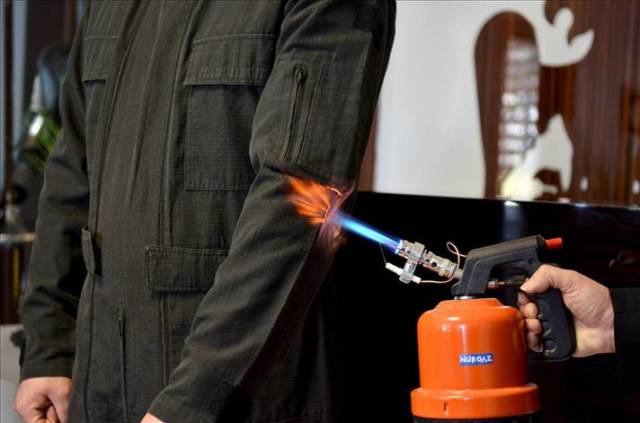Nanotechnological Clothing
In the new world order, everything turns out to be the triumph of technology. High-formula technological products that will touch every aspect of our lives in 10 years are pregnant with many important developments in the field of textiles. Get ready to open your eyes to a completely different world thanks to clothes made with nano particles!
Although nanotechnology textile products have not yet entered our lives fully, they are already a revolution. Efforts to obtain multifunctional smart textile products in many fields, especially in health, safety and information, are continuing intensively. While some works continue at the prototype stage, some products are put into production in limited numbers. The yarns used in textiles are doped with nano particles, preventing bacteria and microbes from living in the clothes we wear, and bad odors become a thing of the past. For example, our clothes will no longer get dirty with fabrics that do not like water and repel water. Thus, the need for washing and ironing will be eliminated, water use will be reduced, and washing machines will not be needed. We do not know how these stories sound to you, but it is certain that nothing will be the same as before.
From UV rays to non-combustible fabrics…
It is planned that nanotechnology, which is perceived as a new technology revolution in the scientific world, will complete its development in 2025 and beyond, and enter all areas of life. It is an undeniable fact that flexible and washable fabrics with nanosensors will add new dimensions to the clothes we use. Stating that fabrics that do not stain and even increase electrical conductivity can be produced, President of the Nanoscience, Nanotechnology and Nanomedicine Association Prof. Dr. İbrahim Uslu explains their usage areas as follows: “The first usage areas of nanomaterials are to prevent UV rays by creating a very high surface area. These fabrics were produced to protect fishermen from the sun, and later, flame retardant fabrics were developed for the use of firefighters. The production of anti-static fabrics is now realized thanks to nanotechnology. Antimicrobial fabrics are produced using nano-silver, zinc or titanium dioxide materials.” Uslu also states that the use of nanotoxic materials during the production of these fabrics may have negative effects on the environment and human health.
Antibiotics can also be added to fabrics
Mr.Uslu, who says that burn-retardant fabrics and wound dressings aiming to heal wounds rapidly, will form new consumables in the textile industry in the future, explains the tests performed as follows: “Polymer raw material, aloe vera with the ability to heal burns quickly, adding antibiotics to textile fabrics to prevent deep wounds from getting germs. It has been observed that the wounds that normally heal in 10 days, thanks to the additives and polymers, are reduced to 3-4 days in experiments on animals.
Electronic revolution in textile
Military-purpose fabrics, which can store solar energy and convert it into electrical energy, also make it possible to charge devices. Fabrics with sensors can protect soldiers against biological and chemical hazards, excessive humidity, high temperature or pressure environments can be detected immediately and the occurrence of negativities can be prevented in advance. In order to prevent soldiers from being exposed to pests such as scorpions, mosquitoes and insects in the desert and similar environments during the war, anti-insect nanotextiles completely eliminate such environmental conditions.

Does nanotextile pave the way for invisibility?
Noting that with the addition of photonic technology applied to nanofabrics, fabrics can change according to the color of the environment like a chameleon, Uslu continues: “Nanotextile fabrics with color change are also used for military purposes. In fact, some scientists in our country have managed to become invisible by producing invisible fabrics. In the near future, fabrics that we cannot even imagine will be produced thanks to nanotextiles. For example, an undershirt will be functional as a mobile phone and provide communication in case of loss. The pilot's attire, which becomes luminous when desired, will make it easier to locate the plane at night, in case the plane crashes. Again, thanks to the features to be added to nanotechnology fabrics, the dress worn by the patient will be able to provide information about drug intake and how much drug is released to which part of the body, so that doctors will be able to monitor patients more closely.
Incentive to nanotechnology from TUBITAK
TUBITAK offers very important incentives and project support to scientists who want to work on the following nanotechnology subjects.
● Nanophotonics, nanoelectronics and nanomagnetism
● Nanocomposites and their fuel cells, piezoelectric and thermoelectric materials
● Characterization of nanomaterials using nanotechnology such as atomic force microscopy
● Production of nano devices with electronic circuits produced by nanofabrication
● All nanotechnology applications from nanobiotechnology and DNA detection to nano drug production
Nanotechnological attack from the Turkish Red Crescent
The Turkish Red Crescent will produce clothes with nanotechnology for its 6,500 employees. The production, which will cost a total of 2 million liras, will be realized in Çorlu. Istanbul Textile and Raw Materials Exporters' Association (İTHİB) redesigned the corporate clothes worn by the Turkish Red Crescent officials in aid activities with nanotextile fabric. For the Red Crescent collection, initially 50 thousand meters of nano technology, antibacterial, breathable, non-flammable, non-wrinkling, non-sweating fabric was used. The collection was designed by the famous fashion designer Hakan Akkaya. The project will cost a total of 2 million liras.
Global nanotechnology R&D spending
● It allocated more than 3.7 Billion USD in 2010 in the USA.
● Since 2001, when the USA started to support nanotechnology as a separate budget item, total support is 12 Billion USD
● In the 7th Framework Program of the European Union, material science and nanotechnology are among the priority areas, and 4.8 billion EUR has been allocated for research in 6 years.
● By enacting the Nanotechnology Promotion Law in 2001, Korea plans to raise 4 Billion USD for nanotechnology research and to train 20,000 nanotechnology experts by 2015.
● The USA (25 percent), Japan, China, Russia, France and England have 70 percent of the total research.

